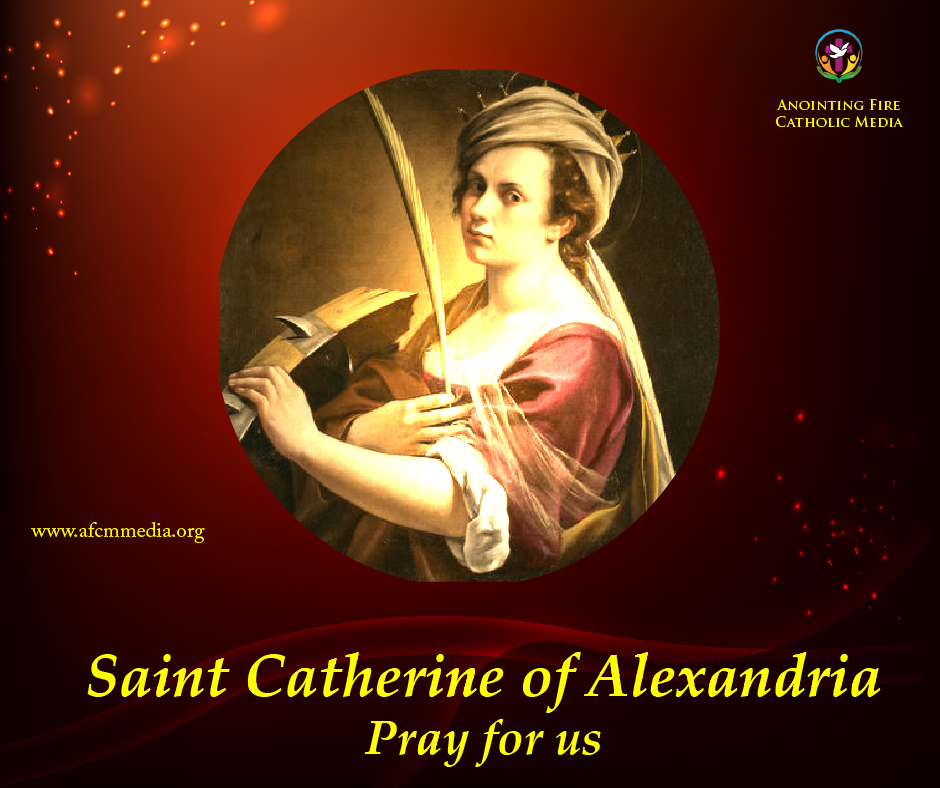|
Saint Catherine of Alexandria
Feast day : 25 November

Saint Catherine of Alexandria, was a young saint, who lived during the period 287-305. Born a pagan, she became a Christian during her teens after the Blessed Virgin Mary along-with Infant Jesus appeared to her in a dream. She soon became skilled in Catholic teachings and boldly defended her faith when the Emperor began persecuting Christians. She successfully debated with pagan philosophers and converted them to Christianity for which she was imprisoned and tortured. But this did not deter her zeal to fight for her faith. Whilst in prison, she converted nearly 200 of the royal guards and the Emperor’s wife and Chief of royal guards by convincing them of the futility of their pagan beliefs. Eventually, she was beheaded and instead of blood, a white substance, believed to be milk, flowed from her mortal wound. Her body was discovered in the 8th century on Mount Sinai in the St. Catherine Monastery which is a popular pilgrim center today. She is the patron saint of philosophers, theologians, preachers, potters, young women, teachers and lawyers. Her feast day is celebrated on 25 November.
Early life:
Saint Catherine was the daughter of Constus, the Governor of Alexandria. She was a pagan from birth until the Blessed Virgin Mary along-with Infant Jesus appeared to her in a dream. In the dream, the Blessed Virgin Mary asked Jesus to accept her into His kingdom to which Jesus said she had not yet been baptised and turned His face away. Saint Catherine immediately abandoned her pagan faith and sought the Sacrament of Baptism. She then became skilled in Catholic teachings and grew in faith. In another dream, Jesus appeared to her and put a beautiful ring on her finger. When she woke up, the ring was still there on her finger. From then on, she consecrated her life to Jesus accepting Him as her Spouse.
When the Emperor began persecuting Christians for their faith, she went to him and boldly defended her faith. She was a skilled orator and the Emperor could not defend his pagan faith. So he gathered 50 pagan philosophers to argue with her. At the end of the debate, they were all convinced of the falsehood of their pagan beliefs and converted to Christianity for which they were immediately martyred!! The Emperor ordered her to be imprisoned and tortured till she gave up her faith. She was scourged brutally till her body was covered with wounds and blood streamed from them. Yet she boldly endured it. The Emperor then ordered that she be put to death by starvation. It is believed that she was fed daily by angels from Heaven and Jesus too often appeared to her and strengthened her resolve to fight. She continued to convince people around her even in prison to give up their pagan beliefs and follow Christ. The Emperor’s wife and Chief of the royal guards visited her in prison and they along-with nearly 200 of the royal guards were converted to Christianity. The Emperor was furious and ordered all of them including his wife to be put to death.
Death:
On losing his wife, the Emperor approached Saint Catherine with a proposal of marriage which she refused saying she was already the spouse of Christ. The Emperor was enraged at this and ordered her to be executed by a spiked wheel which is now called the ‘Catherine wheel’ – a set of wheels with sharp blades that would tear her flesh when it would turn. But when she was brought before it, an angel of the Lord destroyed the machine. It miraculously exploded and the blades from it killed many of the pagans gathered to see her execution. Frustrated and furious, the Emperor ordered her to be beheaded. Eventually, she was beheaded at the young age of 18 years and instead of blood, a white substance believed to be milk flowed from her mortal wound.
Her body is believed to have been discovered around the 8th century in the monastery on the top of Mount Sinai which is today called the St. Catherine monastery. The monks of the monastery discovered her body to be incorrupt, hair still growing and a constant stream of heavenly fragranced oil from her body. The monastery today is a pilgrim site where her incorrupt left hand can be seen. Several miracles have been reported by people who make the pilgrimage and seek her intercession in their needs. She is traditionally revered as one of the 14 Holy Helpers i.e. a group of Saints believed to be very effective in their intercession for our needs. She is the patron saint of philosophers, theologians, preachers, potters, young women, teachers and lawyers. Her feast day is celebrated on 25 November.